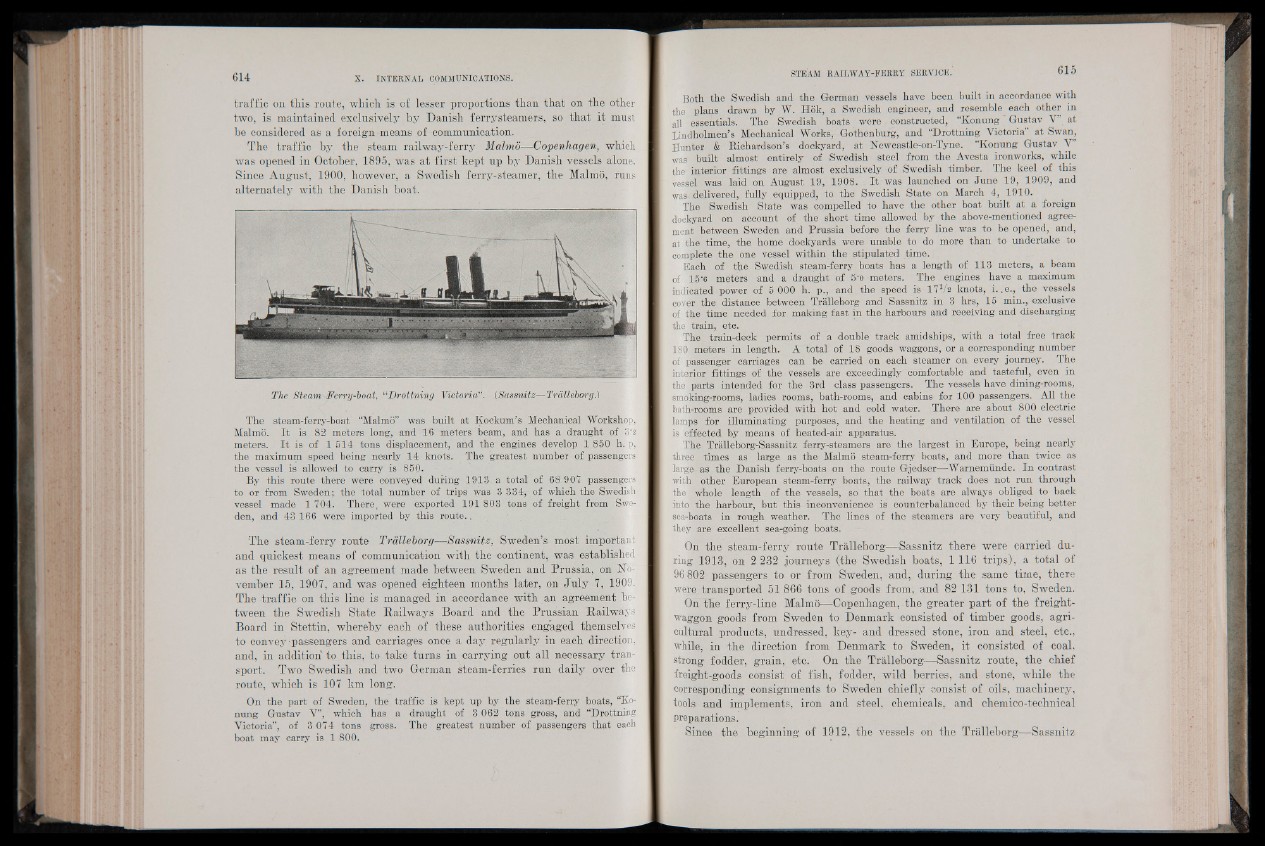
614 X. INTERNAL COMMUNICATIONS.
traffic on this route, which is of lesser proportions than that on the other
two, is maintained exclusively by Danish ferrysteamers, so that it must
be considered as a foreign means of communication.
The traffic by the steam railway-ferry Malmö—Copenhagen, which
was opened in October, 1895, was at first kept up by Danish vessels alone.
Since August, 1900, however, a Swedish ferry-steamer, the Malmo, runs
alternately with the Danish boat.
The Steam Ferry-boat, “Drottning V i c t o r i a (Sassnitz—Tralleborg.')
The steam-ferry-boat “Malmo” was built at Kockum’s Mechanical Workshop,
Malmo. I t is 82 meters long, and 16 meters beam, and has a draught of 3'2
meters. I t is of 1 5 1 4 tons displacement, and the engines develop 1 850 h. p,
the maximum speed being nearly 14 knots. The greatest number of passengers
the vessel is allowed to carry is 850.
By this route there were conveyed during 1913 a total of 68 901 passengers
to or from Sweden; the total number of trips was 3 334, of which the Swedish
vessel made 1 704. There, were exported 191 803 tons of freight from Sweden,
and 43 166 were imported by this route. ,
The steam-ferry route TralleborgBtSassnitz, Sweden’s most important
and quickest means of communication with the continent, was established
as the result of an agreement made between Sweden and Prussia, on November
15, 1907, and was opened eighteen months later, on July -7, 1909.
The traffic on this line is managed in accordance with an agreement between
the Swedish State Railways Board and the Prussian Railways
Board in Stettin, whereby each of these authorities engaged themselves
to convey passengers and carriages once a day regularly in each direction,
and, in addition to this, to take turns in carrying out all necessary transport.
Two Swedish and two German steam-ferries run daily over ,the
route, which is 107 km long.
On the part of Sweden, the traffic is kept up by the steam-ferry boats, “Ko-
nung Gustav V”, which has a draught of 3 062 tons gross, and “Drottning
Victoria”, of 3 074 tons gross. The greatest number of passengers that each
boat may carry is 1 800.
STEAM RAILWAY-FERRY SERVICE. 615
Both the Swedish and the German vessels have been built in accordance with
the plans drawn by W. Hok, a Swedish engineer, and resemble each other in
all essentials. The Swedish boats were constructed, “Konung Gustav V” at
Lindholmen’s Mechanical Works,- Gothenburg, and “Drottning Victoria” at Swan,
Hunter & Richardson’s dockyard, at Newcastle-on-Tyne. “Konung Gustav V”
was built ajmost entirely of Swedish steel from th e Avesta ironworks, while
the interior fittings are almost exclusively of Swedish timber. The keel of this
vessel was laid on August 19, 1908. I t was launched on June 19, 1909, and
was, delivered, fully equipped, to the Swedish State on March 4, 1910.
The Swedish State was compelled to have the other boat built at a foreign
dockyard on account of the short time allowed by the above-mentioned agreement
between Sweden and Prussia before the ferry line was to be opened, and,
at the time, the home dockyards were unable to do more than to undertake to
complete the one vessel within the stipulated time.
Each of the Swedish steam-ferry boats has a length of 113 meters, a beam
of T5‘6 metbrs and a draught of 5'0 meters. The engines have a maximum
indicated power of 5 000 h. p., and the speed is 17V2 knots, i. .e., the vessels
cover the distance between Tralleborg and Sassnitz in 3 hrs, 15 min., exclusive
of the time needed for making fast in the harbours and receiving and discharging
the train, etc.
The train-deck permits of a double' track amidships, with a total free track
180 meters in length. A^Total of 18 goods waggons, or a corresponding number
of passenger carriages can be carried on each steamer on every journey. The
interior fittings of the vessels are exceedingly comfortable and tasteful, even in
the parts intended for the 3rd class passengers. The vessels have dining-rooms,
smoking-rooms, ladies rooms, bath-rooms, and cabins for 100 passengers. All the
bath-rooms are provided with hot and cold water. There are about 800 electric
lamps for illuminating purposes, and the heating and ventilation of the vessel
is effected by means of heated-air apparatus.
The Tralleborg-Sassnitz ferry-steamers are the largest in Europe, being nearly
threes times as large as the Malmo steam-ferry boats, and more than twice as
large-As the Danish ferry-boats on the route Gjcdser Warnemiinde. In contrast
with other European steam-ferry boats, the railway track does not run through
the whole length of the vessels, so that the boats are always obliged to back
into the harbour, but this inconvenience is counterbalanced by their being better
sea-boats in rough weather. The lines of the steamers are very beautiful, and
they are excellent sea-going boats.
On the steam-ferry. route Tralleborg—-Sassnitz there were carried during
1913, on 2 232 journeys (the Swedish boats, 1 116 trips), a total of
96 802 passengers to or from Sweden, and, during the same time, there
were transported 51 866 tons of goods from, and 82 131 tons to, Sweden.
On the ferry-line Malmo—Copenhagen, the greater part of the freight-
waggon goods from Sweden to Denmark consisted of timber goods, agricultural
products, undressed, key- and dressed stone, iron and steel, etc.,
while, in the direction from Denmark to Sweden, it consisted of coal,
strong fodder, grain, etc. On the Tralleborg-—Sassnitz route, the chief
ireight-goods consist of fish, fodder, wild berries, and stone, while the
corresponding, consignments to Sweden chiefly consist of oils, machinery,
tools and implements, iron and steel, chemicals, and chemico-technical
preparations.
Since the beginning of 1912, the vessels on the Tralleborg—Sassnitz